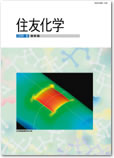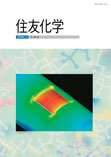FY 2009
vol. 2009 - II (2009.11.30 issue)
-
Sumitomo Chemical Co., Ltd. has developed a new fixed bed hydrogenation process for acetophenone, which is the by-product of propylene oxide production process, in order to produce α-phenyl ethanol, the raw material for styrene monomers. A new copper catalyst has been developed for this process. The catalyst exhibits high activity per unit weight and high selectivity because of the suppression of side reactions such as hydrogenolysis. The competitive power of the PO/SM process has become stronger compared to the conventional process by using this new hydrogenation technology.
(by Takuo HIBI,Shinya ITO,Noriaki OKU,Kiyoshi IWANAGA,Hirofumi KOIKE)
-
Polypropylene (PP) is a typical commodity plastic and has been widely used in many application fields including packaging films, industrial components and miscellaneous goods, due to its excellence in properties such as stiffness, heat resistance and processability in addition to light weight material density and also a relatively low price. The continued demands from the market for higher performances have stimulated, particularly in recent time, the improvement of PP manufacturing processes with newly created ideas. This review describes, mainly based on the information published in literature and patents, an outline of the development history of PP manufacturing processes and an introduction to recent progress, including our own technologies.
(by Hideki SATO,Hiroyuki OGAWA)
-
In response to specific customer needs, we have developed SUMILIZER® GP, SUMILIZER® GS, SUMILIZER® GM, SUMILIZER® GA-80 polymer additives (stabilizing agents) as unique products which have properties hitherto unseen. We have utilized these new properties to apply these unique products in a wide range of applications. This paper describes the mechanism of polyolefin stabilizing agents, and also trends in customer needs as a result of changes in the market environment, and presents the responses our company has made in the field of additives due to these factors. We will also introduce some of the steps we have been taking toward development of our new G series.
(by Toshiya TAKAHASHI,Ryoji SOMA,Kenji KIMURA,Naoki INUI)
-
After the development of a mite allergen quick determining system, we carried out the development of allergen denaturing agents. First, tannic acid was evaluated as an allergen denaturing agent using the ELISA method. Then, we investigated various compounds for use as new allergen denaturing agents and identified materials such as rare-earth metal salts and zirconium salts as potential inorganic compounds, and materials such as cationic compounds as potential organic compounds. We also developed applications for these allergen denaturing agents including trigger type liquids and additives for filters and cleaning equipment.
(by Keiichiro INUI)
-
We have developed SYNSUP and the supporting systems for users to access SYNSUP through both Intranets and the Internet. We herein summarize the history and the current status of the SYNSUP service provided to chemists in our company and also some group companies.
(by Tetsuhiko TAKABATAKE)
-
A new in vivo mutagenicity test, in vivo comet assay, has gained particular world wide attention. The comet assay is a promising technique for evaluating in vivo DNA damage to multiple organs with high sensitivity. However, there is no validated testing guideline based on the optimized experimental techniques. Recently, to establish a standardized testing method, an international validation study for in vivo comet assay has begun with a view to submitting a new OECD test guideline. In this review, we describe the regulatory trends toward this assay for the evaluation of chemical mutagenicity and our investigation of this testing method.
(by Ryoko MATSUYAMA,Keiko OGATA,Sachiko KITAMOTO,Mika OOTA)
-
In recent years, advanced regulations concerning restrictions on the use of hazardous substances have been enforced in the European Union (EU) as environmental pollution control acts. Subsequent to the RoHS (Restriction of the use of certain Hazardous Substances in electrical and electronic equipment) directive for electric and electronic equipment, restrictions on the use of hazardous substances are being examined in the field of all industrial products, where REACH (Registration, Evaluation, Authorization and Restriction of Chemicals) regulations have been enforced. The use of fifteen substances of very high concern has been restricted by the REACH regulations. The European Commission (EC) has submitted proposals to amend the RoHS directive and one proposal is to consider adding four substances to the list of restricted substances. The importance of hazardous substances management in industrial products is increasing more and more from such a background. This paper describes testing methods for restricted substances in industrial products regulated by the EU.
(by Masayuki ONISHI)
-
Sumitomo Chemical Group treats ensuring information security as one of its business issues, and has promoted information security management in the whole group. When managing information security in the group, points to ponder and approaches to take are different from when managing it in a single company. This article will discuss the approaches, issues, solutions for the issues and future efforts regarding ensuring security management in Sumitomo Chemical Group, by using some case examples in Sumitomo Chemical Group.
(by Tatsuhiro SUZUKI)
vol. 2009 - I (2009.5.29 issue)
-
Extrusion lamination is one of the techniques used for laminating different materials, and is widely used as the manufacturing process for packaging films for products such as foods, cosmetics and pharmaceutical products in order to obtain improved film properties such as gas barrier, heat sealing and film strength. Autoclave-type high-pressure low-density polyethylene (PE-HPLD) is generally used in extrusion lamination applications because of its good neck-in property. Recently, however, the packaging industry has desired reductions in the volume of materials and high-speed processing. Therefore, plastic resins with good draw down properties are needed. Sumitomo Chemical Co., Ltd. has developed a tubular-type PE-HPLD which exhibits a good balance of neck-in and draw down properties, although neck-in and draw down properties have a trade-off relation. In this article we investigated the effects of shapes of deckles, and setting positions of deckles and rods on extrusion processing properties. As a result, we made their relations clear. Furthermore, we also carried out a viscoelastic simulation of the extrusion lamination process using computer aided engineering developed by Sumitomo Chemical Co., Ltd. The simulation could predict the neck-in phenomenon and thickness distribution for extruded PE-HPLD.
(by Makoto MORIKAWA,Yasushi MASUTANI,Seiji SHIROMOTO)
-
We had succeeded in the synthesis of a new type of visible light driven photocatalyst called ILUMIO®, which was prepared by an improvement on conventional preparation of ceramics dispersion. The ILUMIO® coated layer decomposes volatile organic compounds (acetaldehyde, formaldehyde and toluene) under fluorescent lamp irradiation. Furthermore, the coated layer exhibits super hydrophilic performance under visible light irradiation. ILUMIO® has dispersing crystalline particles; therefore, the photocatalytic activity is achieved by coating followed by drying without calcination.
(by Yoshiaki SAKATANI,Kensen OKUSAKO,Yuko SUYASU,Makoto MURATA,Katsuyuki INOUE,Yasuyuki OKI)
-
Gottsu-A® is a new microbial insecticide containing spores of strain T1 of the entomopathogenic fungus Paecilomyces tenuipes, which was developed by Sumitomo Chemical Co., Ltd. to control chemical resistant whiteflies on greenhouse vegetables. We have succeeded in developing a fermentation process and a subsequent formulation process for P. tenuipes, as well as developing a unique oil flowable formulation with high performance in the stable preservation of P. tenuipes spores. Gottsu-A® has a low toxicity to natural enemy insects and excellent suitability for integrated pest management (IPM) programs using other selective chemicals, physical control tools and beneficial insects. In this report, the development of Gottsu-A® is described focusing on biological information for P. tenuipes, insecticidal performance on whiteflies, formulation design, production process and toxicological studies.
(by Takeshi MARUYAMA,Eiji NITTA,Shinya KIMURA,Yoshiki TAKASHIMA,Kenji MATSUMURA,Yoshihito DEGUCHI)
-
We developed a two-step design method of diffraction optical elements. In this method diffraction angle and polarization splitting property are adjusted separately by different manners. We also proposed a multifunctional light-guide plate for LCDs that combines the functions of light-guide plate, prism sheet, diffusion sheet, and polarization splitting film. The multifunctional light-guide plate was designed by this two-step design method and was fabricated. The properties of fabricated multifunctional light-guide plate substantially met the design targets.
(by Kiman KIM,Masaaki KUBOTA,Kiyoharu NAKATSUKA)
-
Fitness-For-Service (FFS) assessments are quantitative engineering evaluations to demonstrate the structural integrity of an in-service component that may contain a flaw or damage. FFS assessment has become popular in the past ten years. One of the reasons why the assessment has become familiar is that some engineering standards have been published. Recently, the engineering standards have evolved to be more international and comprehensive, for example, by the release of a joint American Petroleum Institute (API)/ American Society of Mechanical Engineers (ASME) FFS standard. This paper provides an interpretation of local metal loss assessment procedures based on API/ASME FFS standard and experimental and numerical validation analysis results of FFS assessment.
(by Takuyo KAIDA)

